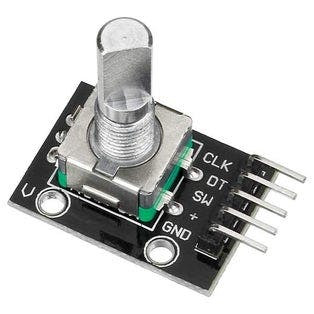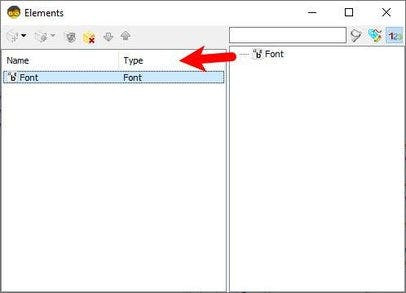Simple Volume Indicator - Gc9a01 Display Using Visuino
About the project
In this tutorial we will make a simple Volume Indicator using GC9A01 SPI Display, rotary encoder, Arduino and Visuino program.
Project info
Difficulty: Easy
Platforms: Arduino, DFRobot, Visuino
Estimated time: 1 hour
License: GNU General Public License, version 3 or later (GPL3+)
Items used in this project
Hardware components
Story






- Arduino UNO (or any other Arduino or ESP)
- GC9A01 SPI Display
- Rotary encoder module
- Jumper wires
- Breadboard
- Visuino program: Download Visuino

- Connect GC9A01 Display pin [VCC] to Arduino pin [3.3V]
- Connect GC9A01 Display pin [GND] to Arduino pin [GND]
- Connect GC9A01 Display pin [SCL] to Arduino pin [13]
- Connect GC9A01 Display pin [SDA] to Arduino pin [11]
- Connect GC9A01 Display pin [DC] to Arduino pin [9]
- Connect GC9A01 Display pin [CS] to Arduino pin [10]
- Connect GC9A01 Display pin [RST ] to Arduino pin [8]
- Connect Encoder module pin [CLK] to Arduino digital pin [2]
- Connect Encoder module pin [DT] to Arduino digital pin [3]
- Connect Encoder module pin [+] to Arduino pin [5v]
- Connect Encoder module pin [-] to Arduino pin [GND]


Start Visuino as shown in the first picture Click on the "Tools" button on the Arduino component (Picture 1) in Visuino When the dialog appears, select "Arduino UNO" as shown on Picture 2
Step 4: In Visuino Add Components



- Add "GC9A01" component
- Add "Rotary Encoder Sensor" component
- Add "Integer Multi Source" component
- Add "Integer To Text" component









- Select "RotaryEncoderSensor1" and in the properties window set "Max" > "Roll Over" to False and "Max" > "Value" to 360
- Select "RotaryEncoderSensor1" and in the properties window set "Min" > "Roll Over" to False and "Min" > "Value" to 0
- Select "MultiSource1" and in the properties window set "Output pins" to 7
- Double click on the "Display1" and in the "Elements" window drag "Draw Angled Line" to the left side and in the properties window set "Color" to aclWhite, "X" to 120, "Y" to 120, "Begin" to 51, "End" to 100, select "Angle" and click on the pin icon and select "Float SinkPin"
- Drag another "Draw Angled Line" to the left side and in the properties window set "Color" to aclBlack, "X" to 120, "Y" to 120, "Begin" to 51, "End" to 100, select "Angle" and click on the pin icon and select "Float SinkPin"
- Drag "Draw Ellipse" to the left side and in the properties window set "Height" to 100, "Width" to 100, "Fill Color" to aclBlue, "Color" to aclBlack, "X" to 70, "Y" to 70
- Drag "Text Field" to the left side and in the properties window set "Size" to 2, "Fill Color" to aclBlue, "Color" to aclWhite, "X" to 100, "Y" to 90
- For Text Field elements in the properties select "Elements", click on the 3 dot button and in the "Elements" window drag "Font" to the left side and in the properties window set "Font" to AdafruitFreeSansBold18pt7b or any other font
- Close all the windows



- Connect Arduino digital pin [3] to "RotaryEncoderSensor1" pin [Direction]
- Connect Arduino digital pin [2] to "RotaryEncoderSensor1" pin [Clock]
- Connect "RotaryEncoderSensor1" pin [Out] to "MultiSource1" pin [In]
- Connect "MultiSource1" pin [0] to "Display1" > "Draw Ellipse1" pin [Clock]
- Connect "MultiSource1" pin [1] to "Display1" > "Draw Angled Line2" pin [Clock]
- Connect "MultiSource1" pin [2] to "Display1" > "Draw Angled Line1" pin [Angle]
- Connect "MultiSource1" pin [3] to "Display1" > "Draw Angled Line2" pin [Angle]
- Connect "MultiSource1" pin [4] to "Display1" > "Draw Angled Line1" pin [Clock]
- Connect "MultiSource1" pin [5] to "IntegerToText1" pin [In]
- Connect "IntegerToText1" pin [Out] to "Display1" > "TextField1" pin [In]
- Connect "MultiSource1" pin [6] to "Display1" > "TextField1" pin [Clock]
- Connect "Display1" pin [Chip Select] to Arduino digital pin [10]
- Connect "Display1" pin [Data Command] to Arduino digital pin [9]
- Connect "Display1" pin [Reset] to Arduino digital pin [8]
- Connect "Display1" Control pin [SPI] to Arduino SPI pin [In]

In Visuino, at the bottom click on the "Build" Tab, make sure the correct port is selected, then click on the "Compile/Build and Upload" button.
Step 8: PlayCongratulations! You have completed your project with Visuino. Also attached is the Visuino project, that I created for this tutorial, you can download it and open it in Visuino: https://www.visuino.eu
































Leave your feedback...